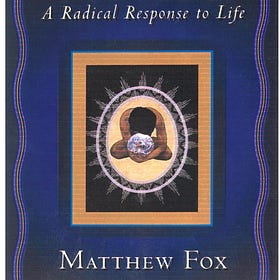Matthew Fox on Contemplation and Four Paths for Spiritual Growth
Last week I shared a conversation I had with one of my spiritual heroes, Matthew Fox. This week I include another lightly adapted excerpt from a transcript of our conversation. For the full conversation, see here:
Matthew Fox on Prayer as a Radical Response to Life
“The Holy Ordinary” is also a pop-up podcast created to support my book The Holy Ordinary, where I interview authors, thinkers, and activists who illuminate the sacred, the just, and the beautiful in the midst of the ordinary.
Two Kinds of Meditation
Mark Longhurst: You raise an important question about the role of contemplation. Is sitting on my meditation cushion praying in this sense of a larger response to life?
Matthew Fox: Contemplation in the form of sitting on a cushion—or not—walking meditation, as Thich Nhat Hanh also recommends has its place, and that’s part of the four paths [see below]: the letting go, the going into silence, and emptying our minds—the kenosis of busyness and worries about the past and the future.
All that practice is one version of meditation. Another version is art as meditation, or making images. The psychologists Claudio Naranjo and Robert Ornstein wrote a good book in the ‘70s called On the Psychology of Meditation. They talk about these two kinds of meditation: introverted, which is sitting on a cushion, and extroverted—but I call it art as meditation.
It’s about birthing. So artists, and when we do artwork, it’s radical—and I don’t mean just painting a picture, but I mean tapping into our creativity. Our creativity is deep within us, isn’t it? So is our silence. So what you’re talking about is finding that silence that’s so deep.
Photo by Susanna Marsiglia on Unsplash
Our creativity is deep within us, isn’t it? So is our silence.
Contemplation and Prophetic Action
Contemplation is not the whole picture of prayer—because prophetic action is prayer, too. Protesting, going to jail [for nonviolence direct action], and all the things that our heroes like Gandhi or Martin Luther King and all the people we hold up did. Jesus, too, was busy resisting; he wasn’t spending all his time on a cushion.
In fact, his cushion was the wilderness. He was a very earthy kind of guy. He found a lot of peace out in nature. Ninety-nine% of his parables build on nature experiences. His observations are so keen about birds that fall from the tree, the rain and the sun, the goats and the wheat and the mustard seeds and all of it—so immersed in the processes of nature and creation.
Jesus’s cushion was the wilderness.
All this is prayer. But in that first chapter [of Prayer: A Radical Response to Life], I’m glad it caught your attention—because I was trying to whittle away what I would call cheap or overly familiar versions of prayer that don't go deep enough.
Contemplation goes deep when it really happens, when you really do it—because it takes you into the nothingness, into the space of silence and stillness. Meister Eckhart says, “Nothing is so like God in all creation as stillness.” But out of that, you give birth. Eckhart also says, “I once had a dream—even though a man—I dreamt I was pregnant, pregnant with nothingness. And out of this nothingness, God was born.”
The Four Paths
So we move from the via negativa, which is contemplation, into the via creativa, which is birthing and creativity. And that’s a root. See, joy and delight are other roots—that’s the via positiva. But so is silence and suffering, of course, which is another part of the via negativa. And then creativity [or via creativa] is another root—to get down and to give birth to yourself and to your view of the world and to your values. That’s creativity, and that's a radical response to life.
Then the via transformativa, which is putting that creativity into the work of compassion and social justice and healing and celebration—that is absolutely from the root too, isn’t it? The via transformativa demands a deep response, and that’s from the root. That’s radical.
That’s what I like about the prayer book: you can name what prayer is, but then the four paths—which I developed later—break it down into these various paths. And contemplation is part of that, but it’s part of the bigger picture that includes all four paths.




"Contemplation goes deep when it really happens, when you really do it—because it takes you into the nothingness, into the space of silence and stillness. Meister Eckhart says, 'Nothing is so like God in all creation as stillness.' But out of that, you give birth. Eckhart also says, 'I once had a dream—even though a man—I dreamt I was pregnant, pregnant with nothingness. And out of this nothingness, God was born.'”
I love this imagery of God as the Nothing and God being born from Nothing. This is the stuff that makes me see radical theology as the theological heir to Eckhart's mystical theology.
How awesome to have this conversation. <3